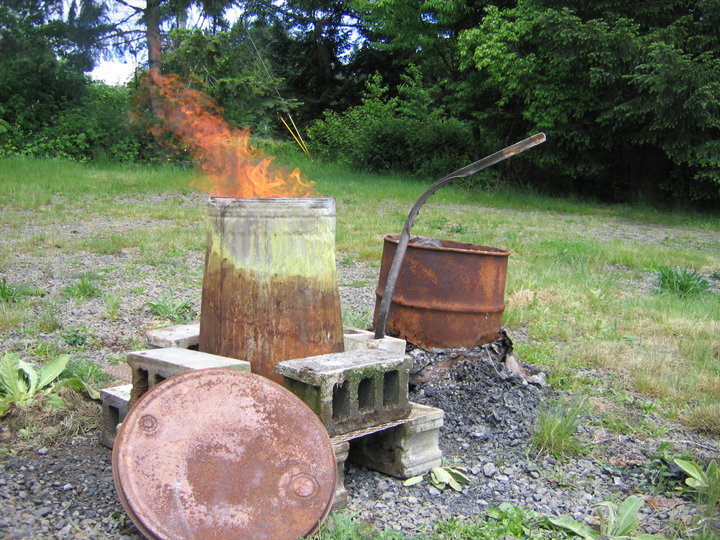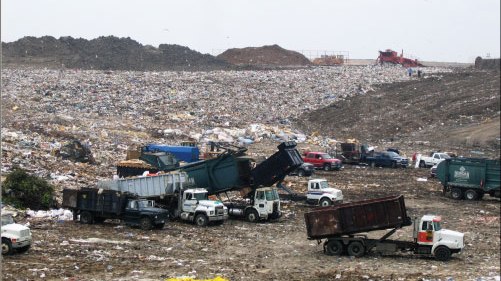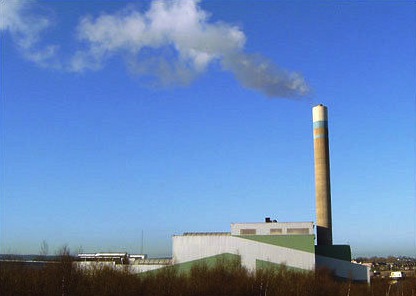Climate Change
Gas Industry Cites Decreasing CO2, Forgets About Increasing Methane
 Maybe you've seen the headlines over the last couple of days. US Carbon Dioxide (CO2) emissions reached an historical 20 year low in the first quarter of 2012. The Federal Energy Administration attributed this decline to three factors: a mild winter, less travel, and gas-powered utility plants replacing coal-fired ones. Whereas coal was producing about 50% of America's electricity in 2005, it's only contributing 34% now, with most of that slack now being taken up by gas-generated electricity.
Maybe you've seen the headlines over the last couple of days. US Carbon Dioxide (CO2) emissions reached an historical 20 year low in the first quarter of 2012. The Federal Energy Administration attributed this decline to three factors: a mild winter, less travel, and gas-powered utility plants replacing coal-fired ones. Whereas coal was producing about 50% of America's electricity in 2005, it's only contributing 34% now, with most of that slack now being taken up by gas-generated electricity.
Gas industry representatives were quick to take credit for the reduction and use it has proof of how climate-friendly natural gas is. But they forgot something important when they did that. They didn't weigh the increase in methane releases caused by gas mining against the decrease in CO2 pollution. Methane doesn't have the lifespan of CO2 in the atmosphere, but pound per pound in the short-term, it's 25 times more potent in its climate change impact. According to climate scientist Michael Mann of the Earth System Science Center at Penn State University, “We may be reducing our CO2 emissions, but it is possible that we’re actually increasing the greenhouse gas problem with methane emissions.”
” A stunning increase in the frequency of extremely hot summers”
 That's James Hansen and other researchers' conclusion after looking at the past 60 years of thermometer readings from Mother Earth. They use last year's $5 billion drought here in Texas as a vivid example of the kind of thing that used to be rare, but no longer is, and they lay the blame squarely on human-made pollution.
That's James Hansen and other researchers' conclusion after looking at the past 60 years of thermometer readings from Mother Earth. They use last year's $5 billion drought here in Texas as a vivid example of the kind of thing that used to be rare, but no longer is, and they lay the blame squarely on human-made pollution.
"This is not a climate model or a prediction but actual observations of weather events and temperatures that have happened. Our analysis shows that it is no longer enough to say that global warming will increase the likelihood of extreme weather and to repeat the caveat that no individual weather event can be directly linked to climate change. To the contrary, our analysis shows that, for the extreme hot weather of the recent past, there is virtually no explanation other than climate change."
“The Conversion of a Climate-Change Skeptic”
 The New York Times publishes a Mea Culpa from the guy whose statments climate change deniers held up as a definitive challenge to the phenomena. Now, they'll probably stop doing that, assuming they make it through his new conclusioins.
The New York Times publishes a Mea Culpa from the guy whose statments climate change deniers held up as a definitive challenge to the phenomena. Now, they'll probably stop doing that, assuming they make it through his new conclusioins.
The Next Big Dallas Environmental Fight? Garbage Burning
 Many folks in the DFW environmental community think the battle over "flow control" at the McCommas Bluff landfill in Dallas is merely a prelude the the bigger goal of locating a large "materials recovery" operation there that will include a waste-to-energy power plant that can generate cash for City Hall as well as electricity. Once confined to the land-starved East Coast and Midwest, garbage burning is coming to Texas under the cover of recycling schemes that want to use it to make a buck instead of paying a landfill to take it.
Many folks in the DFW environmental community think the battle over "flow control" at the McCommas Bluff landfill in Dallas is merely a prelude the the bigger goal of locating a large "materials recovery" operation there that will include a waste-to-energy power plant that can generate cash for City Hall as well as electricity. Once confined to the land-starved East Coast and Midwest, garbage burning is coming to Texas under the cover of recycling schemes that want to use it to make a buck instead of paying a landfill to take it.
A wave of garbage-burning permits have been approved across the country over the last 2-3 years at various cement plants, including the TXI kiln in Midlothian, south of Dallas, which can now burn plastic wastes and the non-steel parts of cars, including brake linings, electronic switches, vinyl covers, mats, and dashboards. Now the groundwork is being put in place to extend that practice into municipal garbage burning using power plants.
The sale pitch sounds great. The waste companies and city will be "completely committed" to recycling and reusing as much waste as possible. They'll only burn a "small percentage of leftover waste" that would otherwise go to a landfill. It has "significant BTU value" and it "reduces pollution" when you burn it! Why bury it when you can use it to make power that people need. It's really just like recycling!
Except it isn't. It's garbage burning. It's burning plastics. It's burning "fibers." It's burning teated lumber. It's burning "a small list of alternative fuels" and when there's not a enough of that stuff to generate the required power, the list expands. And it produces more air pollution, and distributes that air pollution over a much larger area, affecting many more people, than the same amount of garbage continuing to go to a landfill.
The 20-year fight over burning hazardous wastes at TXI and the other Midlothian cement plants began with the companies telling residents that they were "recycling flammable liquids" in kilns that reached almost 2000 degrees, and burned up 99.99% of all the waste. Soon, the cement kilns were mixing in non-flammable solids like toxic metals, and wastes with chlorine, and contaminated water that had little or no BTU value at all. And far from removing 99.99% of the bad stuff, the kilns added a toxic soup of chemicals to their already voluminous amounts of air pollution.
 A landfill's toxic plume is usually slow-moving, flows only downhill, and can be tracked as it goes through soil. An incinerator's plume is blowing toxic air pollution wherever the wind is blowing, traveling as far the the wind will carry it, and changes from day to day, often eluding monitors if they're not in exactly the right place. Then, after all that, there's the problem of what to do with all the toxic ash. Send it to a landfill. Which practice puts more people in harm's way? Which one affects public health more? Which is the more sustainable alternative?
A landfill's toxic plume is usually slow-moving, flows only downhill, and can be tracked as it goes through soil. An incinerator's plume is blowing toxic air pollution wherever the wind is blowing, traveling as far the the wind will carry it, and changes from day to day, often eluding monitors if they're not in exactly the right place. Then, after all that, there's the problem of what to do with all the toxic ash. Send it to a landfill. Which practice puts more people in harm's way? Which one affects public health more? Which is the more sustainable alternative?
As a means of getting tuned up for the fight ahead, which some rumors put as near as this fall or winter, let's examine a little study partially sponsored by the American Chemical Council that was published the other day with the intent of setting the stage for widespread garbage, sorry, "refuse" burning.
It comes from UT – where another study on energy just got a lot of unfavorable publicity. This time It's Dr. Michael Webber who's Associate Director of the Center for International Energy and Environmental Policy in the Jackson School of Geosciences, Co-Director of the Clean Energy Incubator at the Austin Technology Incubator, Fellow of the Strauss Center for International Security and Law at the LBJ School of Public Affairs, and Assistant Professor of Mechanical Engineering at the University of Texas at Austin. Whew.
He's also a member of the "Pecan Street Project" in Austin, which is a "citywide, multi-institutional effort in Austin to create the electricity and water utilities of the future by the innovation and implementation of smart grids, smart meters, and smart appliances. The Pecan Street Project team includes UT, the City of Austin, Austin Energy, the Environmental Defense Fund, the Austin Technology Incubator, and eleven corporate partners."
See? Already the guy has impeccable credentials.
And what is Dr. Webber and the American Chemical council selling today?
"If 5% of residual waste from recycling facilities were diverted to energy recovery, it would generate enough power for around 700,000 American homes annually."
First, you understand that Dallas alone has more than 700,000 homes, and so we're talking about burning 5% of the entire nation's leftovers to get electrical energy for a city smaller than Dallas…for a year.
Second, does anyone know how many waste incinerators would have to be built and and what cost, or how they'd be financed? Nope. But we digress….
"The study found that while single-stream recycling has helped divert millions of tons of waste from landfills in the U.S. – where recycling rates for municipal solid waste are currently over 30% – Material Recycling Facilities (MRFs) currently landfill between 5% and 15% of total processed of the material treated as residue.
According to the researchers this residue is primarily composed of high energy content non-recycled plastics and fibre.
The report proposed that one possible end-of-life solution for these energy dense materials is to process the residue into Solid Recovered Fuel (SRF) that can be used as an alternative energy source capable of replacing or supplementing fuel sources such as coal, natural gas, petroleum coke, or biomass in many industrial and power production processes."
 You will be unsurprised to learn that a cement kiln was involved in "testing" how well the
You will be unsurprised to learn that a cement kiln was involved in "testing" how well the garbage, sorry, SRF burned. Because it can reach temperatures of almost 2000 degrees!
But the results are not exactly spectacular in the way the Chemical Council probably anticipated.
Sulfur Dioxide (Sox) pollution was reportedly reduced over what coal alone would have emitted by some 20 to 44% (the study rounds this number up to "roughly 50%"). OK. but that's what SOx "scrubbers" are for. The study doesn't say whether the kiln used for the experiment had scrubbers on it. Not a lot of them do right now, but most power plants do and any new power plant or cement kiln would have to have them as well. Both the TXI and Holcim dry kilns have scrubbers already, and the new Ash Grove dry kiln will as well. These scrubbers can reduce SOx pollution by over 80%. So can we agree that we're better off just adding scrubbers to facilities instead of setting fire to plastic garbage to reduce this kind of air pollution?
On the other hand Nitrogen Oxide (NOx) pollution reportedly went up 25% to as much as 93%, when garbage was burned compared to coal. This spike was explained away by saying the kiln didn't have a proper delivery system for the garbage to reach the kiln. That's untested speculation by the authors that may or may not be true. Any increase in smog-forming NOx pollution would be hard to sell in an area like DFW that's been in violation of federal smog standards for over 20 years.
CO2 emissions were reportedly reduced by a paltry 1.5% – the equivalent to getting a million cars off the road! But that's another small number when you realize that just treating the CO2 from the three Midlothian cement plants here in North Texas would get you that number or something even bigger.
When you burn plastic you get dioxins – one of the most toxic substances in the world. The Chemical Council knows this. But there was no testing for dioxins, or phthalates, or any of the more exotic kinds of air pollution one would expect to see when you burn plastics and other kinds of garbage. This is one of the primary objections citizens would have about this practice, and yet there was no testing for it.
These results may not seem that great to you, but they impressed both the Chemical Council and Dr. Webber.
"In this case, one person's trash truly is another person's treasure. Americans send tons of waste to landfills each and every day, meaning that one of America's most abundant and affordable sources of energy ends up buried in landfills," commented Cal Dooley, president and CEO of ACC.
"It's time we got smart and made energy recovery a central part of America's energy strategy," he added.
Meanwhile Dr. Webber added: "The findings from our study demonstrate how engineered fuels can make a meaningful contribution to our nation's strategy while reducing carbon and sulfur emissions compared to some forms of energy,"
Let's translate: "Your trash is our potential treasure. We can't portray ourselves as "Green" if we don't find some way to make plastics more eco-friendly. Plus, we can make a buck packaging our garbage for you to burn it. Our findings show that under these very controlled circumstances, and with not too many questions asked, burning garbage can make some minimal pollution reductions that other readily available alternatives could make better, while also increasing the kind of pollution that most people don't want."
This fight over garbage burning will be as big, if not bigger than the fight over gas drilling. It will involve environmental justice issues, toxic pollution, private-public contracts, sustainability, and real recycling vs the fake kind. And lots and lots of doublespeak. Get your waders on.
“Altering the Odds:” Texas Heat Waves 20 Times More Likely than 50 Years Ago
 This year has seen the hottest half year in US history. Last year was one of the 15 hottest years ever recorded. It not only seems hotter. It's actually getting hotter. There's a reason for that, and it ain't sunspots.
This year has seen the hottest half year in US history. Last year was one of the 15 hottest years ever recorded. It not only seems hotter. It's actually getting hotter. There's a reason for that, and it ain't sunspots.
Researchers working at universities in Oregon and England have estimated that "La Nina" weather patterns combined with global warming have increased the likelihood of such record-setting heat waves in Texas by 20 times compared to the 1960's.
Their findings were part of the annual "State of the Climate" report prepared by the National Oceanic and Atmospheric Administration (NOAA) along with a study published in the July issue of the Bulletin of the American Meteorological Society. "Climate change has altered the odds of some of these events occurring," said Tom Peterson of NOAA's National Climatic Data Center.
Carbon dioxide (CO2) steadily increased in 2011, with the global annual average exceeding 390 parts per million (ppm) for the first time since instrumental records began. Many climate scientists now believe that we must decrease that number to no more than 350 ppm in order to avert the worst consequences of climate change.
Dallas City Hall just got through patting itself on the back for reaching its GreenHouse Gas reduction goals of 6 years ago – although it appears that a lot of GHG pollution within the city of Dallas wasn't actually inventoried to get that pleasant result. The city is now grappling with a new gas drilling ordinance that could send annual GHG totals for Dallas soaring. What is the responsibility of a city that, on the one hand, promotes itself as a regional leader in air quality efforts, and on the other hand, wants to open itself up to the un-and-under-regulated emissions of gas mining and processing?
Proposed Corpus Pet Coke Plant Too Dirty for New Power Plant Rules
 A $3 billion proposed power plant that would sit on Corpus Christi's bay and emit over 13 million tons of Greenhouse pollution a year may never be built because it can't meet new EPA power plant emissions rules. That's the headline of this Monday Fuel Fix article by the Houston Chronicle's Matthew Tresaugue.
A $3 billion proposed power plant that would sit on Corpus Christi's bay and emit over 13 million tons of Greenhouse pollution a year may never be built because it can't meet new EPA power plant emissions rules. That's the headline of this Monday Fuel Fix article by the Houston Chronicle's Matthew Tresaugue.
Chase Power was planning on opening the the Las Brisas (the Breezes) power plant in 2013, but that may never happen unless the company or the state of Texas is successful in lawsuits against the Agency's New Source Performance Standards.
Those standards don't apply to older plants, but they do apply to power plants under construction or planned, like Las Brisas. They require all power plants to achieve greenhouse emission limits that are difficult to meet without CO2 sequestration or other carbon-eating technology.
Las Brisias is designed to burn Petroleum Coke, a refinery by-product that is particularly nasty and releases as much carbon as coal. If it ever is built, it would instantly become the fourth largest CO2 polluter in the state.
Instead of trying to adapt or find a technology that could greatly reduce its carbon footprint, Chase Power is joining Texas in suing the EPA, while also petitioning to get an exemption from the Agency that would allow it to disregard the new greenhouse gas rules. Their local Congressman, Rep. Pete Olsen, is more than happy to oblige them.
Why Isn’t This Happening in Midlothian?
 A Zachary Construction Company-owned San Antonio cement plant is finally going forward with the nation's first full-scale carbon capture plant .
A Zachary Construction Company-owned San Antonio cement plant is finally going forward with the nation's first full-scale carbon capture plant .
Austin-based Skyonic Corp. will build a $125 million facility by 2014 to recycle 15% of the cement plant's CO2 emissions, or about 83,000 tons a year, into less-harmful byproducts such as bicarbonate soda. It also promises to filter acid gases and heavy metals pollution out of the kiln's plume.
Skyonic has a patented process called "SkyMine" that it says converts carbon dioxide emissions into baking soda and can be retrofitted to any industrial plant. The company received $25 million in stimulus funding from the Department of Energy toward the final cost of the San Antonio facility.
The project was first announced in 2010, but had trouble attractign addtional private funding until now.
Cement plants are among the largest point sources of CO2 on the planet, and the industry as a whole accounts for just over 5% of the world's human-made CO2 . Kilns are among the first wave of facilities that had to inventory their Greenhouse Gas pollution for EPA in 2010, and are expected to be targeted for actual reuductions in the future.
Modernization among the three large cement plants in Midlothian has reduced their carbon foot print over the last 20 years, but they still remain the largest point sources for CO2 pollution in North Texas, with over two million tons of emissions annually self-reported by Ash Grove, Holcim, and TXI in that 2010 inventory – the latest we have.
Listen Up: Bill Nye the Science Guy Schools Big Media On Climate Change
 Here's yet another scientist saying that reporting climate change as a he said/she said, two-sided controversy is wrong-headed and akin to giving flat-earthers "an equal say" every time we talk about astronomy. Only this time it's Bill Nye, THE Science Guy:
Here's yet another scientist saying that reporting climate change as a he said/she said, two-sided controversy is wrong-headed and akin to giving flat-earthers "an equal say" every time we talk about astronomy. Only this time it's Bill Nye, THE Science Guy:
Science educator Bill Nye on Monday told CNN that they weren’t doing the public any favors by giving climate change deniers equal airtime because “the two sides aren’t equal.”
“There are a couple of things that you can’t really dispute,” Nye explained to CNN’s Carol Costello. “Sixteen of the last 17 years have been the hottest years on record. That’s just how it is.”
“I appreciate that we want to show two sides of the stories — there’s a tradition in journalism that goes back quite a ways, I guess — but the two sides aren’t equal here. You have tens of thousands of scientists who are very concerned and you have a few people who are in business of equating or drawing attention to the idea that uncertainty is the same as doubt. When you have a plus or minus percentage, that’s not the same thing as not believing the whole thing at all.
Public Warming to Climate Change
 Via Climate Progress, news of a new survey on climate change from the Brookings Institute in DC shows a solid majority of the public accepts the fact of climate change. Although not yet back up to the 70% plus rates seen before 2008, support has increased almost 15 points from its nadir in the Tea Party Spring of 2010. According to the same survey the most influential factor in this shift is not accumulation of scientific evidence but the day-to-day anecdotal experience of most Americans – 68% said recent mild winters had influenced their thinking.
Via Climate Progress, news of a new survey on climate change from the Brookings Institute in DC shows a solid majority of the public accepts the fact of climate change. Although not yet back up to the 70% plus rates seen before 2008, support has increased almost 15 points from its nadir in the Tea Party Spring of 2010. According to the same survey the most influential factor in this shift is not accumulation of scientific evidence but the day-to-day anecdotal experience of most Americans – 68% said recent mild winters had influenced their thinking.
